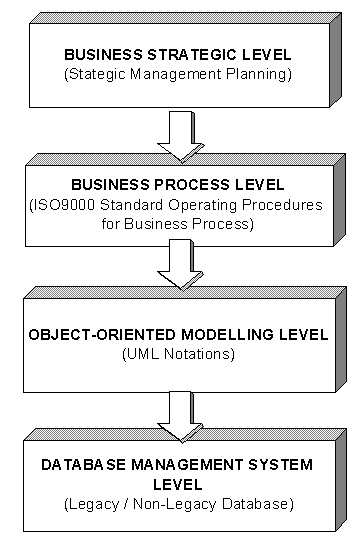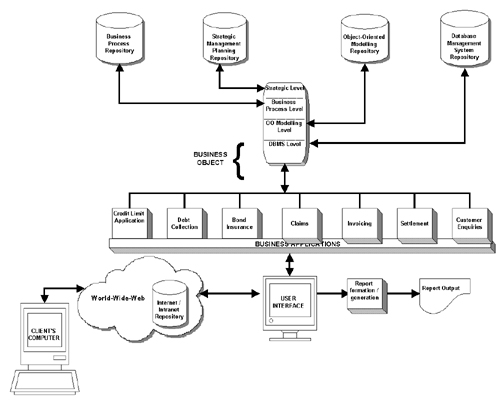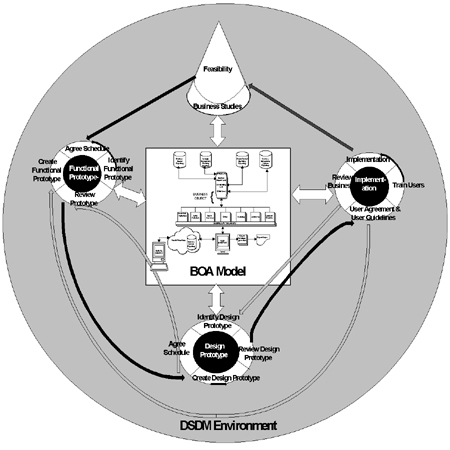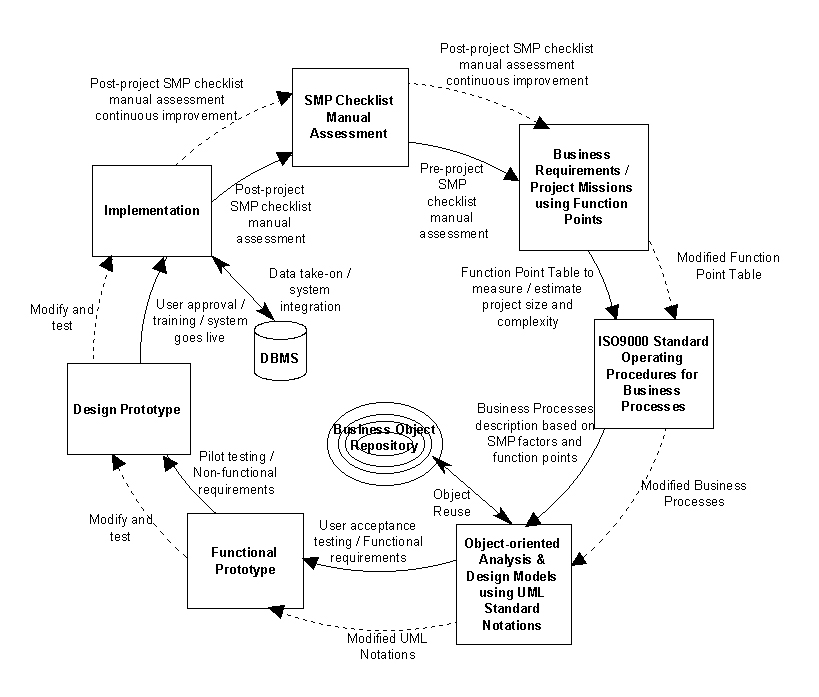
 OOPSLA'98
Business Object Workshop IV
OOPSLA'98
Business Object Workshop IV
1. INTRODUCTION
Nowadays, information system plays a crucial role in most business organisations. The fast pace of technological advancement has leveraged the utilisation of information technology (IT) from organisations in their corporate strategic management planning (SMP). An efficient SMP can no doubt assist organisations in improving their business performance. However, organisations are still facing some obstacles and challenges when implementing their business strategies using IT. Business management personnel have found it difficult to justify how much business benefit they can gain from the software they use to support them to achieve their business objectives such as increasing profitability, gaining competitive advantage.
On the other hand, the current climate of software development is still focusing on the analysis and design methods, programming and user interface techniques. It only emphasises how to “produce software” rather than how to “deliver business solutions”. Such effort cannot warrant the achievement of business objectives. The bottom line problem lies to an absence of tools / methods to: (1) form a direct linkage between the business strategies and the day-to-day business operations; (2) reflect the way how the day-to-day business operations to support the designated business strategies; (3) ensure the software applications for supporting the business operations have met the business criteria; (4) to review the effectiveness of the business strategies against the ultimate business goals.
The above absenteeism is largely attributed to the communication gap
between the business stakeholders and the software developers. Hence
this paper presents a Dynamic Business Object Architecture (DBOA) to integrate
the information technology (IT) to business strategies.
The motivation behind the DBOA development is to improve the communication
between the business end-users and IT developers and to ensure ultimately
the key business objectives are properly supported by the resulting software
systems. It can be summarised by the following issues:-
- to apply a technique to develop information system to support organisational
strategic management planning and management decision making;
- to build a framework to identify organisation’s business strategies;
- to identify the processes underpinning these business strategies;
- to model these business processes into data manipulated object
components hence to transform the literal based narrative statements into
computer based software programs;
- to enhance the potential of object reuse thus to improve maintainability,
to reduce costs, resources and time;
- to make business end users and IT developers to work closely together
The key linking abstraction in the DBOA approach is a new, coarser-grained and semantically richer notion of a Business Object. Business Objects (BO’s) have been adopted by a broad range of developers in different areas such as: client/server distributed architecture [Casanave 95] [Sutherland 95], vertical industry application domain [Poirier et al 95] [Johnson et al 96] [Choudhury et al 97], workflow management [Schulze et al 96] [Baker 96] [Schulze 97] [Paul et al 97] [Beedle 97] [le Comte 97], business processes [Hertha et al 95] [Ramackers et al 95] [McCathy et al 95] [Guido et al 97] [Haugen 97], design patterns [Fowler 96] [Evitts 96]. These approaches are predominately software application driven.
The BOs used in the DBOA are driven by business strategy. It is a conceptual
framework in identifying, modelling and mapping the business strategies
onto supporting software systems, together with an associated management
process, iterative prototyping lifecycle environment and end users’ involvement.
4.1 Business Object Development
DBOA is the development of a Business Object Architecture (BOA) developed under a Dynamic Systems Development Method (DSDM) life-cycle environment. The BOA contains a collection of BO’s where each BO co-ordinates four levels of activity namely: (1) Strategic Management Planning (SMP); (2) ISO9000 Standard Business Procedures for Business Processes; (3) Object-Oriented Business Process Modelling and (4) System Design and Integration with Legacy / Non-Legacy Database Systems. Figure 1 illustrates the 4-level development of a Business Object.

4.1.1 Business Strategic Level:
The first level is the business strategic level where corporate business
strategies are identified, examined and defined. Strategic Management
Planning (SMP) is created. The SMP is set by the business domain
experts who have in-depth knowledge in their business domain and it is
one of the critical success factors to involve business end users in the
system development. SMP is comprised of various SMP maps which contain
all the related factors, together with detailed definitions, to carry out
different strategies. The definitions are to assist the users to
determine the context levels in the SMP checklists (to be created after
the SMP maps) based on their organisation’s situation at the time of their
assessment. The checklists serve the purpose of planning/implementing/reviewing
how the software can support the SMP. The checklists should be reviewed
and updated periodically to reflect the degree of performance improvement.
The SMP assessment is to be rolled over through the Dynamic Systems Development
Method (DSDM), an iterative prototyping lifecycle environment where business
end-users and software developers work closely together.
4.1.2 Business Process Level:
The second level is the business process level where business processes
are annotated to support specific strategies through the process improvement
technique using the ISO9000 standard operating business procedures to identify
and define the tasks and actions needed to achieve the goals as set
in the SMP.
4.1.3 Object-oriented Modelling Level:
The third level is the object-oriented (OO) modelling level where object
models are developed, based on the business processes, using the Unified
Modelling Language (UML) notations. Business processes are modelled
by UML notation. By this stage, objects and classes have emerged
corresponding to the key data storage concepts and generic business procedure
components essential to the business in question. These are demonstrably
reusable across the various business strands captured through a series
of case study projects.
4.1.4 DBMS and Legacy Systems Level:
The fourth level is the database management system level, a substrate
of legacy and/or non-legacy information systems, which must interface with
the OO layer in the BO in order to allow data take on and system configuration
and integration with hybrid OO and Non-OO.
4.2 Business Object Architecture Development
The Business Object Architecture (BOA) as illustrated in Figure 2 is the framework in which individual BO’s are related according to the common strategies, processes, objects and database stored in their own repositories, thereby promoting the reuse of software components, business processes and business strategies within a business domain.

4.3 Dynamic Business Object Architecture Development
The Dynamic Systems Development Method (DSDM) lifecycle provides an environment for BOA development. An integrated approach is proposed and a DBOA is illustrated in Figure 3. Development phase is divided into five time-boxes namely:

4.3.1 Time-box 1: Feasibility Study
Business management personnel do the pre-project SMP checklist manual
assessment exercise to reflect the current situation before meeting the
business objectives. The function point table is created in this phase.
4.3.2 Time-box 2: Business Study
As a result of the pre-project SMP checklist manual assessment, those
strategic factors not meeting the business objectives would be fed forward
to the ISO9000 Standard Operating Procedures for Business Processes document.
The business processes are strongly linked to the objectives to meet.
The Object-oriented analysis & design UML standard notations are used
to model the business processes.
4.3.3 Time-box 3: Functional Prototype
A prototype is created with the functionality enough for the users
to test. Users are allowed to change their business requirements.
Users’ feedback is collected and application will be modified for the next
prototyping testing. Design models and documentation are also updated
in accordance with the user requirement changes.
4.3.4 Time-box 4: Design Prototype
By this stage, the application should have all the functionality agreed
in the project. Since time-boxing control is to ensure project will
be delivered on time and within budget, in the design prototyping stage,
users are not allowed to change their business requirements. However,
they can require changes in screen handling and user interface design.
4.3.5 Time-box 5: Implementation
The activities in time-box 5 include: system debugging, user acceptance
testing, user training, system integration, configuration and system goes
live.
4.3.6 Post-project review
The post-project review should take place 2-3 months after the system
has gone live to allow enough time to evaluate the business performance
against the business goals. Business management personnel carry out
a post-project SMP checklist manual assessment exercise. Any failure
of meeting the business objectives will trigger the modification of business
processes, as well as system modelling and application development.
The SMP checklist manual assessment should take place a minimum of every
6 months.

5. CONCLUSION
The DBOA has provided a mechanism to improve the communication gap between
the software developers and the business management hence the essence of
the software will become more strategically based and industry-focused.
The manual assessments on the SMP checklists during the pre- and post-project
phases have enabled organisations to justify how the software can support
their SMP. The integration of IT to business is to raise the software
developers’ awareness that when business strategies and software applications
are linked together to form a single pool of knowledge, software development
is more likely to support the business strategies hence to achieve the
business goals.
6. FURTHER WORK
The underlying DBOA framework has been designed, to offer a complete
conceptual framework and lifecycle basis for business application development.
A prototype business object repository, based on hyperlink documents and
web-launched plug-in tools, has been developed. An implementation
of the DBOA through an e-commerce project case study is on-going.
At the time of submitting this paper, outstanding tasks include:-
- The post-project assessment of the SMP checklist with the business
end-users to evaluate the DBOA against the SMP. Any identified failures
to meet business objectives will trigger the process improvement stage,
which filters through the object modelling and application design.
- At the moment, the SMP checklists are still very generic for any
organisations in any industries. It is necessary to streamline the
SMP checklists by customising them to suit different business sectors.
- The development of an automated tool to link the SMP checklist templates
to the ISO9000 Standard Operating Procedure for business process templates
and the business process templates filter through the object modelling
and application design to eliminate error prompt.
[Baker 96] Baker M. “Workflow Meets Business Objects” in the Conference
of Object-Oriented Programming Systems Languages Application (OOPSLA’96)
Business Object Design and Implementation Workshop II. October 1996, San
Jose, CA, USA. (Source: http://www.tiac.net/users/juth/oopsla96/oo96final.html)
[Beedle 97] Beedle M. “A ‘light’ distributed OO Workflow Management
System for the creation of Enterprise Architecture in BPR environment”
in the Conference of Object-Oriented Programming Systems Languages Application
(OOPSLA’97) Business Object Design and Implementation Workshop III. October
1997, Atlanta, GA, USA. (Source: http://jeffsutherland.org/oopsla97/oo97final.html
)
[Casanave 95] Casanave C. “Business-Object Architectures and Standards”
in the Proceedings of the Conference of Object-Oriented Programming Systems
Languages Application (OOPSLA’95) Business Object Design and Implementation
Workshop I. October 1995, Austin, TX, USA. Springer-Verlag, London, 1997.
ISBN 354060962, pp 7-28.
[Choudhury et al 97] Choudhury I and Patel D. “Business Object Modelling
Approach to develop a Customer Services framework to enable horizontal
Reuse across Vertical Industries” in the Conference of Object-Oriented
Programming Systems Languages Application (OOPSLA’97) Business Object Design
and Implementation Workshop III. October 1997, Atlanta, GA, USA. (Source:
http://jeffsutherland.org/oopsla97/oo97final.html )
[Constantine 96] Constantine L. “Objects As If People Mattered”
in the OOPSLA’96 Conference, San Jose, CA, October 1996. (Source: http://www.acm.org/sigplan/oopsla/oopsla96/html).
[Digre 95] Digre T. “Business Application Components” in the Proceedings
of the Conference of Object-Oriented Programming Systems Languages Application
(OOPSLA’95) Business Object Design and Implementation Workshop I. October
1995, Austin, TX, USA. Springer-Verlag, London, 1997. ISBN 354060962, pp
151-165.
[Evitts 96] Evitts P. “Business Objects, Business Patters” in the Conference
of Object-Oriented Programming Systems Languages Application (OOPSLA’96)
Business Object Design and Implementation Workshop II. October 1996, San
Jose, CA, USA. (Source: http://www.tiac.net/users/juth/oopsla96/oo96final.html)
[Fowler 96] Fowler M. “Analysis Patters and Business Objects” in the
Conference of Object-Oriented Programming Systems Languages Application
(OOPSLA’96) Business Object Design and Implementation Workshop II. October
1996, San Jose, CA, USA. (Source: http://www.tiac.net/users/juth/oopsla96/oo96final.html)
[Grothehen et al 95] Grothehen T and Schwarb R. “Implementing Business
Objects: CORBA Interfaces for Legacy Systems” in the Proceedings of the
Conference of Object-Oriented Programming Systems Languages Application
(OOPSLA’95) Business Object Design and Implementation Workshop I. October
1995, Austin, TX, USA. Springer-Verlag, London, 1997. ISBN 354060962, pp
87-93.
[Guido et al 97] Guido G and McCarthy W. “Accounting as Romance: Patterns
of Unrequited Love and Incomplete Exchanges in Life and in Business Software”
in the Conference of Object-Oriented Programming Systems Languages Application
(OOPSLA’97) Business Object Design and Implementation Workshop III. October
1997, Atlanta, GA, USA. (Source: http://jeffsutherland.org/oopsla97/oo97final.html
)
[Haugen 97] Haugen R. “Radically Distributed Supply Chain Systems”
in the Conference of Object-Oriented Programming Systems Languages Application
(OOPSLA’97) Business Object Design and Implementation Workshop III. October
1997, Atlanta, GA, USA. (Source: http://jeffsutherland.org/oopsla97/oo97final.html
)
[Johnson et al 96] Johnson R and Yoshida K. “Models of Business Objects:
Accounts” in the Conference of Object-Oriented Programming Systems Languages
Application (OOPSLA’96) Business Object Design and Implementation Workshop
II. October 1996, San Jose, CA, USA. (Source: http://www.tiac.net/users/juth/oopsla96/oo96final.html)
[Kossman 95] Kossman R. “An Architectural Framework for Semantic Inter-Operability
in Distributed Object Systems” in the Proceedings of the Conference of
Object-Oriented Programming Systems Languages Application (OOPSLA’95) Business
Object Design and Implementation Workshop I. October 1995, Austin, TX,
USA. Springer-Verlag, London, 1997. ISBN 354060962, pp 63-68.
[le Comte 97] le Comte R. “Business Process and Workflow Management
in an Enterprise Resource Planning Context” in the Conference of Object-Oriented
Programming Systems Languages Application (OOPSLA’97) Business Object Design
and Implementation Workshop III. October 1997, Atlanta, GA, USA. (Source:
http://jeffsutherland.org/oopsla97/oo97final.html).
[McCarthy et al 95] McCarthy W and Geets G. “Modeling Business Enterprises
as Value-Added Process Hierarchies with Resource-Event-Agent Object Templates”
in the Proceedings of the Conference of Object-Oriented Programming Systems
Languages Application (OOPSLA’95) Business Object Design and Implementation
Workshop I. October 1995, Austin, TX, USA. Springer-Verlag, London, 1997.
ISBN 354060962, pp 94-113.
[Paul et al 97] Paul S, Park E and Chaar J. “essential Requirements
for a Workflow Standard” in the Conference of Object-Oriented Programming
Systems Languages Application (OOPSLA’97) Business Object Design and Implementation
Workshop III. October 1997, Atlanta, GA, USA. (Source: http://jeffsutherland.org/oopsla97/oo97final.html
)
[Poirier et al 95] Poirier S and Ashford C. “Semantics: The Key to
Interoperability” in the Proceedings of the Conference of Object-Oriented
Programming Systems Languages Application (OOPSLA’95) Business Object Design
and Implementation Workshop I. October 1995, Austin, TX, USA. Springer-Verlag,
London, 1997. ISBN 354060962, pp 69-74.
[Ramackers et al 95] Ramackers G and Clegg D. “Object Business Modelling,
Requirements and Approach” in the Proceedings of the Conference of Object-Oriented
Programming Systems Languages Application (OOPSLA’95) Business Object Design
and Implementation Workshop I. October 1995, Austin, TX, USA. Springer-Verlag,
London, 1997. ISBN 354060962, pp 77-86.
[Schulze et al 96] Schulze W, Bohm M and Meyer-Wegener M. “Services
of Workflow Objects and Workflow Meta-objects in OMG-compliant Environments”
in the Conference of Object-Oriented Programming Systems Languages Application
(OOPSLA’96) Business Object Design and Implementation Workshop II. October
1996, San Jose, CA, USA. (Source: http://www.tiac.net/users/juth/oopsla96/oo96final.html)
[Schulze 97] Schulze W. “Fitting the Workflow Management Facility into
the Object Management Architecture” in the Conference of Object-Oriented
Programming Systems Languages Application (OOPSLA’97) Business Object Design
and Implementation Workshop III. October 1997, Atlanta, GA, USA. (Source:
http://jeffsutherland.org/oopsla97/oo97final.html).
[Schwaber 95] Schwaber K. “SCRUM Development Process” in the [Baker
96] Baker M. “Workflow Meets Business Objects” in the Conference of Object-Oriented
Programming Systems Languages Application (OOPSLA’96) Business Object Design
and Implementation Workshop II. October 1996, San Jose, CA, USA. (Source:
http://www.tiac.net/users/juth/oopsla96/oo96final.html)
[Sutherland 95] Sutherland J. “The Object Technology Architecture:
Business Objects for Corporate Information Systems” in the Proceedings
of the Conference of Object-Oriented Programming Systems Languages Application
(OOPSLA’95) Business Object Design and Implementation Workshop I. October
1995, Austin, TX, USA. Springer-Verlag, London, 1997. ISBN 354060962, pp
29-36.